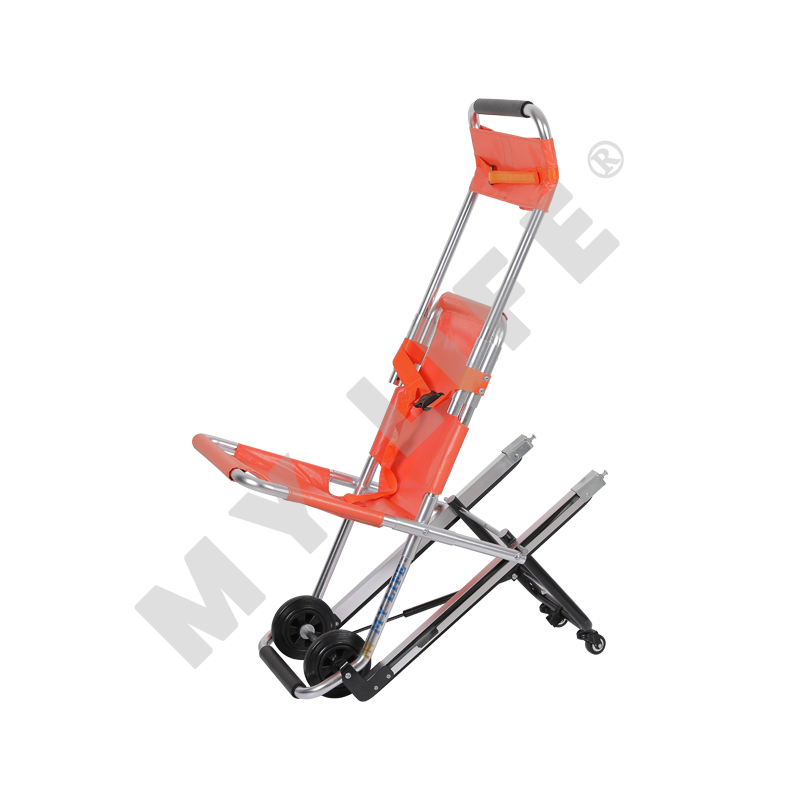How much do you know about medical stretchers?
A medical stretcher is a medical device designed to stabilize a patient. They are often called gurneys, stretchers or stretchers. In order to use, the basic stretcher requires two people. These devices come in all shapes and sizes and can be used to support various weights and sizes. There are stretchers designed for bariatric patients, wheeled stretchers and pediatric crib stretchers.
A wheeled medical stretcher is an outpatient device designed to safely and efficiently transport seriously injured or ill people to a location where they can receive medical care. These devices usually have straps to hold the patient in place and may have other functions, such as supporting infusion equipment.
Although the term "wheeled stretcher" is not necessarily a new invention, it is a piece of equipment that has grown in popularity over the past few years. Stretchers are a very important part of any medical facility's medical equipment arsenal. Therefore, they are often cleaned after each use to prevent the spread of infection.
Most wheeled stretchers are made of a combination of tubular aluminum frame and synthetic material suspended between two poles. This combination allows the stretcher to be easily folded into a compact size. Plus, the fold-out slides have built-in push handles for easy access. Some models even include a locking caster for easy mobility and storage.
One of the more interesting features of the wheeled medical stretcher is its ability to lift a patient from a resting position to an upright position. The height of the stretcher can be adjusted by pressing the height controls on both sides of the unit.
The best wheeled stretchers are made of lightweight materials like aluminum, so they can fit through tight spaces with ease. They can also be equipped with battery-powered hydraulics, making it easier for EMS personnel to keep patients comfortable. Integrated lugs help lock the stretcher in the ambulance's spring-loaded latch. Other features of the wheeled stretcher include side rails, a fixed frame, and a removable telescoping IV pole.
Another feature that makes a wheeled stretcher useful is its ability to move quickly. With the right setup, a stretcher can be a mobile waste rack in the field or a handy casualty transfer system in an emergency room.
Many simple stretchers are actually used in disaster relief because they can be easily transported from one place to another. Other products, such as mobile care stretchers, are designed for mobile medical environments. This model features an asymmetrical backrest, a dual base lift mechanism and a 4" thick mattress.
The design of the 5th wheel is a great idea for smoother turns and straight-line motion. It's also a big improvement over the previous stretcher version. And, with its 750-pound weight capacity, it can carry seriously injured or ill patients.
The Bariatric Medical Stretcher is specially designed to meet the needs of overweight patients. They are a critical part of the safe, efficient transport of overweight patients. An obese patient is someone who weighs more than 300 pounds. Depending on their condition, they may require specialized monitoring and treatment equipment. These patients require respect and professional care.
The Bariatric Medical Stretcher provides a wider platform and extra comfort for the patient. These stretchers are equipped with built-in safety features such as an integrated CPR release mechanism and foot pedal controls. Additional features include an extra-wide patient surface, solid steel construction, heavy-duty casters, and left and right side entry.
The Stretcher is a reliable, affordable, durable and economical bariatric medical stretcher. It's also very versatile. This stretcher is an excellent choice for a variety of medical facilities, including hospitals, clinics, obstetrics and home healthcare providers.
The stretcher has many useful features such as retractable side rails, 12-inch folding side rails, 3-inch padding, locking caster system, and 600-lb weight capacity. With these amenities, it's easy to see why this stretcher is so popular among EMS professionals.
Many obese patients are transported by ambulance. Traditionally, EMS workers use standard Sked stretchers. However, they don't always fit into tight spaces. However, a weight loss stretcher is an ideal solution. Especially in larger facilities it can provide better patient comfort and easier repositioning.
Whether you're a hospital, clinic, or private company, you need bariatric stretchers to transport patients safely and efficiently. When choosing a stretcher, keep in mind the extra space and weight it takes up in the ambulance. Fortunately, there are many excellent options to choose from.
If you are unsure which type of medical stretcher is best for your facility, you can contact one of the suppliers listed below for more information. Most of these companies strive to provide the best possible customer service. You can trust them to make sure your patients get the care they deserve.
Pediatric crib stretchers offer many benefits to patients and caregivers. One of the most important benefits is keeping your child safe and secure while in the sling. Another is that they are designed with kids in mind. A good example is the slatted design of the side rails. This feature ensures that sudden drops do not occur.
The pediatric stretcher of the future features four independent low-impact side rails in a slatted design. These features help reduce stress on the caregiver in the sling and help prevent sudden falls. They're also balanced, which means they're less likely to flip over. To prevent this from happening, two of the four casters lock to ensure the stretcher stays securely in place.


● THE STRETCHER IS MAINLY USED FOR TRANSFER THE PATIENT UP AND DOWM FORM STAIRS, OR OTHER NARROW AREAS.
● IT IS MADE OF HIGH-STRENGTH ALUMINUM WITH FOUR WHEELS.
● THE SURFACE OF THE STRETCHER IS MADE OF LEADER FABRIC WHICH CAN BE TAKE DOWN FOR THE ZIPPER ON BACK.
● THE BACK OF THE STRETCHER DESIGNED WITH FOUR FOLDED HANDLES.
● THE STRETCHER WITH BELTS TO MAKE SURE THE PATIENTS SAFETY DURING TRANSFER THE PATIENTS.

 英语
英语 中文简体
中文简体






